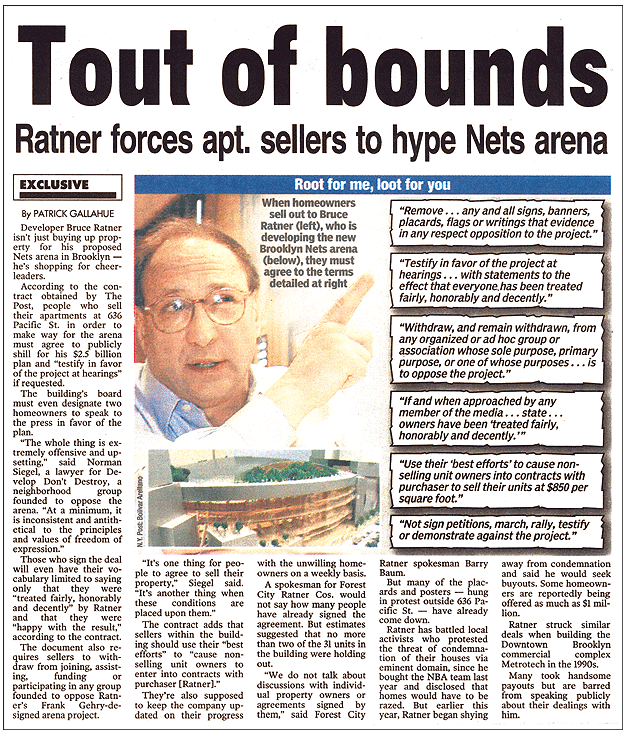Scholars suggest eminent domain for Atlantic Yards was framed as detached from governmental responsibility
Let's take a look at When the Street Disappears: Eminent Domain, Redevelopment, and the Dissociative State, published in the May 2018 issue of PoLAR: Political and Legal Anthropology Review.
Despite the state’s dissociation from the developer during the negotiations with residents, the successful assemblage of land was implicitly guaranteed by New York State’s initial cooperation at the public announcement, in essence making Atlantic Yards what many critics of the scheme pejoratively called “a done deal.” If one reads only the state’s official documents in the absence of the ethnography that uncovered what had led up to their drafting and distribution, it appears as if FCRC [developer Forest City Ratner Companies] was able to rapidly acquire properties from willing sellers. This ethnography, however, reveals not only the activists’ perspective of an unfair process but also how less-involved publics (that is, nonactivists and residents beyond the footprint) could come to interpret the FCRC’s dealings as completely fair. Our excavation of the experiences and records of local residents, along with official documents and media coverage, also reveals the implicit power of the neoliberal state’s “dissociative state.”
(Emphases added)
Indeed, their interviews and analysis show that many beyond the oft-quoted activists believed the process in which Forest City acquired property--both rental buildings and buildings/condos--was perfectly fine.
I'm not sure if they're suggesting that only their ethnography undermines the notion that Forest City got properties from willing sellers, or just that their ethnography helps corrects the record formed by official documents.
After all, while their ethnography valuably airs voices not typically acknowledged, it should not be the sole source--given ample documentation from the press, documentary film/play, and project opponents--to help critique the official documents.
A fair deal?
In the end, the “fair business deal,” despite activists protestations, seems to be the most salient memory of the process of land assemblage, which itself, with contractual prescriptions and proscriptions to speaking about it, essentially erased people’s rights to other legal subjectivities.
Our purpose is not to debate the validity of eminent domain use in this case. Rather, our purpose is to use ethnography to show how and why the legal consciousness of some people, especially activists, is at odds with the court and with the actions, or inactions, of the state.
In the Atlantic Yards process, “the public” had been a moving target: the audience of media, the presumed endorsers of big projects via politicians who represent them, the broader residents of Brooklyn, and even the several hundred “justly compensated” displaced residents. The mobility of the idea of the public enabled the state to operate with a minimally public process, and with little need for street-level bureaucrats.
Developers and journalists took up that function in the case, as we have shown. For legal scholars and activists, a question remains: what are the legal, cultural, and ethical responsibilities of private companies if they are partners in business with a democratic state, when both entities, albeit at different times in the partnership, act as if they have no association with each other and perhaps, at times, with the law
The site, which includes a railyard and public and private land, strikes a historical echo in Brooklyn. In the 1950s, Walter O’Malley, the owner of the Brooklyn Dodgers, wanted to build a stadium there to replace Ebbets Field.
FCRC, as a private entity, may well have been within bounds to negotiate with anybody a contract that prescribes or proscribes the speech of the parties involved. Since the company was also using $100 million in public funds to purchase properties, and had the state’s promise to use eminent domain, protestors questioned the legality of the Atlantic Arts Agreement on the grounds that its stipulations were an overreach, given the corporation’s partnership with and reliance on the state to get its business done.It's a little more complicated. We didn't learn that Forest City was being reimbursed with public funds for those specific properties until April 2008, after much of the controversy had crested. So my scoop never got the attention that the Daily News's "BONANZA" or the Post's "Tout of Bonds" got.
The article made no critical commentary connecting the power of the state to force their moves with a company that also denied sellers their First Amendment rights to criticize the public–private partnership that made the transactions possible and necessary. In fact, in the thirteenth paragraph of this thirty-three-paragraph story, the reporter wrote: “For this article, [FCRC] agreed to waive contractual restrictions limiting what those who accepted buyouts could say” (Confessore 2006). This situation is reported as if it were commonplace for the newspaper of record in the United States to have an entity, in this case FCRC, in partnership with and dependent on the state, waive restrictions to free speech.
Q: How will the project affect current residents?A: It will create housing, jobs and open space, with minimal displacement....Forest City Ratner is working diligently to reduce the impact on residents— continuing its long history of working with businesses and community leaders to ensure that residents are compensated for moving costs and the value of their homes, at above-market rates. For tenants, Forest City Ratner will build new apartments as quickly as possible so renters will have the opportunity to move back into the development immediately.
Without using the words “eminent domain,” the flyer framed the taking of private land as justified by what the project “offered” to the public. Likewise, without actually quoting it, the flyer alluded to the Fifth Amendment’s takings clause, stating that compensation would be not only “just” but also generous and swift.
As I've long argued, these flyers deserved to be critiqued in real time as a cousin of political advertising, which by then was getting critiqued. So consider that Trinch/Snajdr article a contribution, however delayed, to raising that consciousness.



Comments
Post a Comment